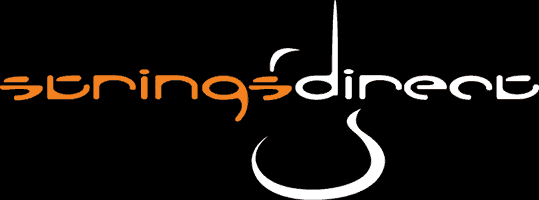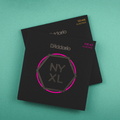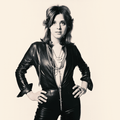JOHN MAYER
By Strings Direct – 29 August, 2023
"I’ll tell you, the argument about string gauges is about the silliest thing a guitarist can engage in."

JOHN MAYER: HISTORY
This week’s player spotlight takes us stateside again to take a closer look at one of the most emulated and influential guitar players of today’s generation. A true guitar hero and one that continues to influence players young and old. Ladies and Gents… Mr. John Mayer.
Born to school teacher parents in Fairfield, Connecticut, John started guitar at the age of 13 after seeing Michael J. Fox play 'Johnny B Goode' in Back to the Future. Soon after a neighbour lent him a Stevie Ray Vaughan cassette, and from then his love of SRV (and all things Blues-Rock) took off becoming his biggest influence.
In fact, as a teenager John worked tirelessly at a gas station (that's petrol station to us Brits) in order to save up and buy his first 'proper' guitar: a Fender SRV Signature Stratocaster! His influence is literally marked on him with John even sporting an SRV tattoo on his upper arm.
Early in his playing career John was also heavily influenced by the Blues greats including Eric Clapton, Buddy Guy, Freddie King, Albert King, B.B. King, and more... who all made an impact on the young John Mayer. No stone was left unturned as he delved deep into their back catalogues, honing his craft along the way.
In 1997 at the age of 20, he enrolled in the world famous Berklee College of Music but dropped out a year later choosing to move to Atlanta, Georgia to further his solo career.

ALBUMS: INSIDE WANTS OUT & ROOM FOR SQUARES
John’s move to Atlanta wasn’t simply an escape from college but more of a purposeful opportunity to focus on his burgeoning solo career. Whilst in Atlanta, John released his first EP 'Inside Wants Out' and then went onto release his first full album 'Room for Squares'.
Throughout these early years in his career, John toured and recorded relentlessly to promote his music. It’s fair to say that at this point in his career, he was pigeonholed as more of a singer/songwriter predominantly playing acoustic-led songs with little evidence of his heavily Blues-influenced former years.
It’s not until you witness some of his earlier live work that you get to see opportunities for his electric guitar prowess to shine on through. Great evidence of this is on his first live DVD 'Any Given Thursday' from 2002. Check out his solo from Covered in Rain (2 mins 40 secs)… if this isn’t a guitar player stretching his wings we’re not sure what is!
John followed up this release with his second album, 'Heavier Things' and his third LP 'Continuum'. By this point he was well in his stride both as a songwriter and guitar player. At the time, Continuum was his most critically acclaimed and arguably best album to date.
Fantastic songs were accompanied by stellar guitar work which certainly did not detract from the quality of the songwriting, in fact it bolstered it!! The playing was never there just for playings sake. Every note was chosen carefully crafting solos you could recite as much as the lyrics themselves.
JM3 - JOHN MAYER TRIO
It was around this time that John joined forces with Steve Jordan and Pino Palladino to create the John Mayer Trio, aka JM3.
Their first television appearance was on a telethon to help support the victims of the 2005 Tsunami. John was originally scheduled to be joined by Steve Jordan and bassist Willie Weeks but late on Weeks was forced to pull out with Steve Jordan suggesting a certain Pino Palladino to fill his shoes; and fill them he did!!
Performing a cover of Hendrix’s “Bold as Love” the chemistry, power and energy between these three musicians was clear to see and from here the John Mayer Trio was born.
JM3 supported The Rolling Stones on several of their US tour shows and they also played a small US headline tour of their own. This was a real opportunity for John Mayer to flex his guitar playing muscle. In a power trio, there’s nowhere to hide and John certainly didn’t do that.
Stepping up to the plate, he displayed incredible playing and again this was another milestone in his ‘guitar playing’ career and he was starting to truly cement his 'Guitar Hero' status. JM3 released their album 'Try!' which featured enduring hits such as “Who did you think I was”, "Vultures" and "Try!" amongst several covers too.

LIVE IN LOS ANGELES
After the tour and album release, The John Mayer Trio made several further TV appearances but it wasn’t until Mayer’s 2009 film “Live in Los Angeles” that they were seen performing together again.
This CD/DVD release was a culmination of John Mayer’s career to date. The show included three performances; an initial acoustic set, a further set by the John Mayer Trio and a final full band set. This night was a perfect representation of the talents of John Mayer both as a songwriter, performer and musician. One of our personal favourites from that performance is Slow Dancing in Burning Room.
Soon after John released his 4th studio album, Battle Studies (one of our personal favourites here at Strings Direct) with standout track for us Assassin. In the following years, John decided to move away from New York to a more rural setting in Montana.
John underwent two bouts of vocal surgery forcing him to take somewhat of a hiatus. It was also an opportunity to escape the media circus surrounding his personal life at the time and a chance to shake off his playboy persona that he was admittedly guilty of playing up to.
It wasn’t until 2012 that he released 'Born and Raised' which was quickly followed up by 'Paradise Valley' in 2013. Whilst these records may not have received the chart popularity of his earlier career, by now, he had a legion of fans that hung on his every word and every note played. These releases didn’t need chart success and instead represented a more mature Mayer. Some would even say these albums saw a more folky side of John Mayer but with enough focus on the guitar playing to satisfy even the hardiest of Mayer fans.
Back in May 2018 several of us here at Strings Direct were fortunate to witness John Mayer live at The O2. The tour was in support of his album ‘ The Search for Everything’ and the night consisted of three separate performances including a short set from the JM3. Being so close to the man himself, we all agree, it’s a night we’ll not forget any time soon and a pleasure to see a performer at the very pinnacle of his game.
John’s latest album, Sob Rock, was released just a few months ago (July 2021). The album delivers a deliberate dose of 80’s nostalgia to many of the tracks (and the marketing and merchandise supporting the release definitely adds to this vibe too!). Despite the album having a retro flavour, there’s some classic Mayer in there… You only have to listen to the first track ‘Last Train Running’ to know that the guitar fanatics thirst will be more than quenched. In fact, his latest single from the album ‘Wild Blue’ certainly gives a tip of the hat to Mark Knopfler… check out that solo!!
Right about now, John Mayer is not just an out and out solo artist. He’s performed with his own bands and is admired by not only his fans but his fellow peers too. Throughout the years he’s become somewhat of a musical chameleon and a very much in-demand collaborator.
He’s never been shy in joining forces with other artists; regularly popping up on plenty of other recordings, sitting in on sessions and accompanying artists from a whole host of different musical genres on live performances.
This is no more evident than most recently as he joined former Grateful Dead band members to create Dead and Company back in 2015. What was meant to only start out as a few gigs has turned into a well established group that continues to tour on a regular basis.
JOHN MAYER: GUITAR STRINGS

So what guitar strings does such a guitar hero use?
Well, for much of his early career, John Mayer was a D’Addario endorsee playing both their EXL Nickel Wound range and EJ Phosphor Bronze strings. But back in 2006, John made the move over to Ernie Ball and has been an advocate for the California-based string giant ever since.
He’s seen in plenty of Ernie Ball’s advertisements promoting both their nickel wound Slinky and Earthwood acoustic ranges. According to Ernie Ball, he plays Regular Slinky (10-46) and Power Slinky (11-48) strings for his electric guitars.
2024 Update:
Ernie Ball Silver Slinky
John Mayer now plays his own Ernie Ball Silver Slinky signature set, gauges: 10.5, 13.5, 17.5, 27w, 37w, 47w.
On 10th October 2024 John Mayer announced a collaboration with Ernie Ball to produce a signature set of strings called 'Silver Slinky'. Silver Slinky is unique half gauge set between Regular Slinky and Power Slinky.
“I’ll tell you, the argument about string gauges is about the silliest thing a guitarist can engage in. Maybe you get a better tone off of bigger strings, but if you can’t bend up to the note, what’s tone anyway? But like Hendrix probably had .010s, so it’s whatever you can bend.”
From that quote it's evident that John is very much a feel player when it comes to both his guitars and strings, tailoring his gauges based on how the guitar feels to him. In an interview talking about his heavily relic’d 1963 Strat (nicknamed ‘The Black One’) he said:
"Some guitars you'll put 0.011s on, and it's like [makes abrupt noise] and you just can't move around… But that one [The Black One] just has a little extra slack; like a little leeway."- Music Radar
“What makes your choice of favourite guitar out of 5 of the exact same guitars?I think, if I’m guessing correctly, it’s something to do with the slack in the strings. That to me is what a guitar is. 90% of the guitar is the string. I play the string, the guitar is underneath that. I’m playing the string!!”
In the interview with Music Radar he goes on to say;
"Y'know, I still can't get a guitar manufacturer to explain to me why two guitars that are made in exactly the same way, why one of the guitars has more [string tension] slack than the other.
They will tell you like; No, the scale length is exactly the same. So why are these strings tighter? You know what I mean? And why do these ones go loosey goosey and all buttery?"
PRS Silver Sky
John Mayer cites this as one of the reasons he made the move over to PRS and pursued the opportunity to design his signature model. The controversial 'Silver Sky' is John Mayer’s take on the famous S-Style guitar taking it to the levels that he always wanted but felt unable whilst still affiliated with Fender.
“It’s built bespoke for me… If I gave my guitar away, for the first time I can then go to a Guitar Center, pull a guitar off the wall and it will feel just like the one I had for 20 years, which is super cool!” - Thick Skin with Jeff Ross Podcast.
In his early career, John was pretty much exclusively a Fender player (more specifically a Strat guy). But, as his career has evolved, inevitably so has his guitar collection!! This is very well documented all over the internet and over the years he’s been seen playing a whole host of guitars from various brands such as Gibson, Jackson, Guild, Duesenberg, Music Man and many more.
With many of his songs written in standard tuning, we presume, John chops and changes between 10’s and 11’s to account for the difference in scale length of his guitars and the little nuances in ‘feel’ to each and every instrument (outside of his Silver Skys).

Different scale lengths can alter the way strings feel, and many players often opt for different gauges to help achieve some sort of consistency in playability when changing from guitar to guitar.
ACOUSTIC MAYER
Acoustically, he’s rarely seen playing anything else but Martin guitars, in particular his signature OM-28JM model and 00-42SC Parlor Guitar (see image below).
We did notice on one particular Ernie Ball advert from around 2006, Ernie Ball showed a pack of 13-56 gauge, however, judging by the most recent Ernie Ball adverts, John plays Earthwood Phosphor Bronze 12-54 strings. Whilst described as ‘Light’ gauge, this is a fairly standard gauge and something you’d come to expect from somebody who regularly plays 10’s and 11’s on the electric side of things.
If he does play 13’s at times, we can only assume that again this is to account for a change in tuning, much like for tunes such as ‘In Your Atmosphere’ and the always frustratingly hard to nail ‘Neon’.







